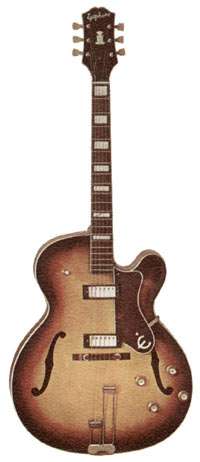
The Epiphone Broadway was a very fine carved top acoustic guitar produced in New York (and latterly Philadelphia) by Epiphone. It first shipped in 1931.
“It is now built with curly maple back and sides, hand carved and graduated top of choicest straight grained spruce and mahogany neck, to make this model a beauty in appearance as well as tone and performance”
The Broadway was a large bodied instrument, 20 3/4" x 17 3/8" with some very nice ornamentation. The headstock inlays were typically mother of pearl, with several different designs used, including 'Epiphone Broadway Masterbilt' in scrolled text, the Epiphone 'i', and the ornate flower design shown here on the Broadway featured in the 1954 Epiphone catalogue. It featured large neck position markers, also pearl, starting at fret one.
Towards the end of production, the Broadway body depth was reduced. Up until mid 1966 (including in the 1966 Epiphone Catalogue) the depth at guitar rim was stated at 3 7/16". As of the October 1966 price list, this was reduced by just over half an inch to 2 7/8". The fact that this change corresponds to the peak in Broadway shipping numbers is probably no coincidence,
 1960s Gibson-built Epiphone Broadway
1960s Gibson-built Epiphone BroadwayWhen Gibson first launched its line of Epiphone guitars in the late fifties after buying Epiphone, new instruments were typically given names (with the exception, it seems, of the Sheraton) of older Epiphone models. The new Broadway was a dual pickup electric acoustic guitar, but with the same body size and shape, the same large-size block inlays, and the same Frequensator tailpiece. Gibson settled on the original Epiphone 'i' headstock motif, used previously. A fully acoustic version was not offered.
Many of the new Epiphone models had a Gibson equivalent, and for the Epiphone Broadway, it was the Gibson ES-175D. Both were full body depth, twin pickup jazz boxes, with a maple body and mahogany neck, and a similar level or ornamentation. Both had a free floating rosewood bridge, and rosewood fretboard. They were around the same price point: in September 1963, the Broadway was $385/$405 for Shaded and Natural finishes respectively; the ES-175D slightly cheaper at $365/$380. The Broadway was a little wider bodied though, 17 3/8" versus 16 1/4" of the ES-175D, and most obviously the ES-175 had a sharp Florentine cutaway rather than the rounded Venetian cutaway of the Broadway.
In total 608 guitars were shipped from Kalamazoo during the years 1959-1969, with the peak years being 1966 and 1967. During the Gibson years, Epiphone just produced two full depth electric guitars: the Broadway and the Howard Roberts.
The shipping data below shows an anomaly in the model designations in 1959. Whether this was an error in the released shipping data, or represents an actual change in model name is unclear. What's more, Cherry is only listed as a finish option in 1967. It was included in price lists as of September 1964, and as Cherry and Shaded (Sunburst) actually had the same E252 model code, they were most likely lumped together in the figures for 1964-66; there were most likely more than 24 Cherry Epiphone Broadways produced by Gibson.
| 1959 | 1960 | 1961 | 1962 | 1963 | 1964 | 1965 | 1966 | 1967 | 1968 | 1969 | total | |
| E251N | 19 | 19 | ||||||||||
| E252 | 68 | 34 | 32 | 29 | 43 | 28 | 43 | 82 | 92 | 9 | 9 | 469 |
| E252N | 7 | 12 | 12 | 13 | 15 | 6 | 28 | 3 | 96 | |||
| E252 Ch. | 24 | 24 | ||||||||||
| total | 87 | 41 | 44 | 41 | 56 | 43 | 49 | 110 | 119 | 9 | 9 | 608 |
The Broadway was reissued in 1997, and is a very nice guitar, though naturally without the price tag associated with the carved-top originals - currently widely available. Although broadly similar to the 1960s Kalamazoo-built original, at least in size and in terms of hardware, it was appointed more in keeping with the Emperor and Sheraton models, having their 'tree of life' headstock inlays, and 'abalone triangle in pearl' block neck position markers.
$3200
$3800